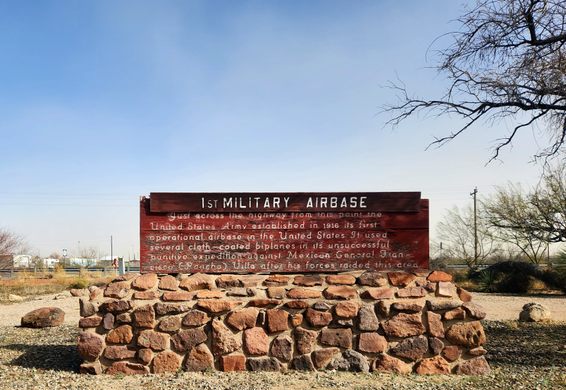Pancho Villa State Park
Located near the U.S.-Mexico border, this park remembers the famous raid of General Francisco “Pancho” Villa and his soldiers.
The Mexican Revolution was a complex series of conflicts that spanned roughly from 1910 to 1920. Initially with the goal of toppling the dictatorial regime of Porfirio Díaz, once that was achieved the battles continued on and off for years in a war over which faction would replace him. From this war of shifting alliances and governments rising and falling emerged the legendary figure of Francisco “Pancho” Villa.
Villa was 32 years old at the outbreak of the Mexican Revolution in 1910. His life before the revolution was troubled and hard. He worked many laborious jobs, including as a sharecropper, butcher, bricklayer, railroad worker, and miner. He also occasionally stole horses and roamed northern Mexico as a highway bandit.
When the Mexican Revolution began Villa was inspired to use the skills that served him well as a bandit in the toppling of the dictatorship. His fearlessness and bravado against larger and better-armed enemies and his skill as a horseman and in guerrilla warfare soon made Villa a valuable part of the revolutionary campaign, which successfully brought down the Díaz regime in 1911.
The revolution continued, with factions seizing power, betraying one another, establishing their own dictatorships, and subsequently being overthrown. Villa spent more time in prison during this period and only barely escaped the firing squad. While imprisoned he received a political education and eventually he found an opportunity and escaped from prison.
With only a handful of men under his command, Villa achieved a heroic comeback and soon rose to become the leader of the most powerful faction in Mexico. He began a series of hit-and-run attacks on military convoys and on wealthy ranches, taking food, guns, and money, and escaping on horseback into the wilderness. His widely publicized exploits attracted thousands of followers to join up with his Division of the North. In 1914, the revolution was successful again, and again the victorious factions began to fight against themselves.
Until this point, the United States’ involvement in the revolutions was somewhat detached. For the sake of U.S. business interests invested in Mexican resources they hoped the chaos would wind down, but they were also willing to sell arms to any faction that could pay. That ended here, with the U.S. firmly siding against the more radical factions, including Pancho Villa’s, in favor of the factions representing wealthy landowners. Additionally, the United States allowed Villa’s opponents to move men and supplies into the United States and back down into Mexico on American railroads while denying that privilege to Villa’s army. A series of devastating defeats followed and by the end of 1915 Villa was once again on the run.
Pancho Villa held the United States largely responsible for his change in fortunes and sought to strike at America in his effort to rebuild. Like before, he hoped a series of hit-and-run guerrilla attacks would allow him to rearm and attract new recruits. To inaugurate this campaign he targeted the border town of Columbus, New Mexico, and the U.S. 13th Cavalry Regiment stationed there.
On March 9, 1916, Pancho Villa led a pre-dawn raid into Columbus. Despite taking everyone by surprise, the American cavalry soon recovered and after several vicious hours of combat, the Mexican revolutionaries retreated back across the border. The town of Columbus was nearly entirely destroyed but Villa’s forces were further crippled and now the United States wanted revenge on Pancho Villa.
The United States sent 10,000 men into Mexico to capture or kill Pancho Villa. The U.S. military hunted Villa for nearly a year, but the seasoned guerrilla leader managed to evade capture. Despite this, he was never able to rebuild his Division of the North into what it once was. The U.S. military withdrew from Mexico in 1917 and Villa continued his skirmishes against the Mexican government until 1920, when he and his remaining soldiers were offered amnesty and a plot of land. In 1923, Pancho Villa was killed (it is widely believed he was assassinated by the Mexican government.)
Pancho Villa’s raid on Columbus, New Mexico, and the U.S. government’s retaliatory expedition into Mexico was notable for several reasons. Villa’s raid marked the last time foreign soldiers invaded the continental United States and the chase for Villa was the last time the U.S. cavalry was used in a military conflict. It also marked the first time the U.S. military utilized motorized vehicles and airplanes. In 1959, the state of New Mexico established Pancho Villa State Park on the site of the raid and former military base to commemorate and remember these events.
Know Before You Go
Admission is $5. Camping is available in the park. Check the website for the hours of the park museum, as they are seasonal.

















Follow us on Twitter to get the latest on the world's hidden wonders.
Like us on Facebook to get the latest on the world's hidden wonders.
Follow us on Twitter Like us on Facebook